This post may include affiliate links. Thank you for your support.
This easy recipe for Butternut Squash Pasta is ready in 30 minutes or less using simple ingredients! Featuring silky pasta, caramelized butternut squash, and crunchy walnuts in a delicious brown butter sauce. Topped with dollops of creamy ricotta, this pasta with butternut squash packs tons of yummy flavor! It’s the ultimate cozy dinner you and your family will love.
Continue to read on for simple tips and helpful tricks for preparing the perfect butter squash with pasta every single time! And, don’t miss the step by step photos at the bottom of the post!
Update: This post was originally published in October 2016. I’ve made updates to the post below to include new photos and more information about butternut squash spaghetti. Plus, I’ve included step-by-step photos and a recipe video to show you how quick and easy this brown butter pasta is to make!
Hi friends! Are you ready for an easy, cozy meal? Because, I have got some seriously fabulous, flavorful pasta for you that is sure to become a family favorite!
Table of Contents
- About this recipe for butternut squash pasta
- What’s in butternut squash pasta?
- FAQs: butternut squash with pasta
- Serving pasta with butternut squash
- How to make butternut squash pasta, easy?
- Storing butternut squash and pasta
- More quick and easy pasta recipes!
- More butternut squash recipes!
- Butternut Squash Pasta Recipe
About this recipe for butternut squash pasta
This insanely easy pasta is totally on point and all sorts of winning in the cozy dinner department, friends!
This squash pasta is bursting with both flavor and texture! It features silky al dente pasta, beautifully caramelized cubes of butternut squash, nutty parmesan cheese and salty walnuts tossed in a rich brown butter sauce. Finished with a generous dollop (or three) of decadent, creamy whipped ricotta and a sprinkling of crisp sage leaves, this pasta is complex, rich and incredibly flavorful!
Essentially, meatless meals don’t get any more delicious than this! This savory spaghetti is buttery and decadent, yet light and delicate with the perfect hint of subtle sweetness! It’s the perfect fast and flavorful, cozy dinner option you absolutely need in your life!
Plus, this recipe is a total breeze to throw together – it uses common ingredients and it’s ready in 30 minutes or less! And, it’s totally customizable, so you can get your creative juices flowing and toss in your favorite ingredients! Prefer meat? Add some sausage! Looking to add more greens to your diet?! Throw in some spinach! I encourage you to take this recipe and make it your own!
What’s in butternut squash pasta?
This squash spaghetti pasta is comforting and bursting with rich flavor! This recipe is made with 7 simple ingredients, plus a few pantry staples, to create an easy pasta dinner you and your family will love!
Below are the ingredients I typically use. However, this recipe is flexible! Be sure to scroll down and read about how to adapt this recipe to your specific taste or needs!
Ingredients in this recipe
- Pasta: This recipe calls for 12 ounces of dry pasta. I tend to use spaghetti, linguine or bucatini; however, you can use whatever variety of pasta you love! (See below for pasta variety substitutions!)
- Butter: Use unsalted butter so you can control the level of saltiness in the dish!
- Squash: You need 2 pounds, or roughly 4 cups of butternut squash for this pasta. (See below for tips on selecting the perfect squash at the store!)
- Spices: Ground ginger, nutmeg cumin, cayenne, kosher salt and ground black pepper all provide a delicious balance of flavor!
- Garlic: Two cloves of garlic provide a subtle, yet distinctive, punchy taste. Use fresh garlic, not the minced variety sold in the jar.
- Sage Leaves: Sage leaves become delicate and crunchy when fried! They add flavor to the brown butter sauce and serve as a delicious garnish!
- Ricotta: Whole-milk ricotta provides a rich, creamy flavor that truly takes this pasta to the next level of yum!
- Walnuts: Nuts in pasta may sound odd, but once you try it you won’t go back! Walnuts add a beautiful texture that complements the silky pasta! I highly recommend toasting the nuts to enhance their flavor and crunch!
- Parmesan: 1/2 cup of parmesan cheese adds a subtly sharp, yet complex flavor. Use authentic Parmigiano Reggiano or aged parmesan for the best taste. And, make sure you freshly grate the cheese yourself! That green container of parmesan at the store is lackluster in flavor! I like to use my food processor to save time, plus it gets the parmesan perfectly grated!
Recipe variations
Want to make some changes to this butternut pasta?! Fantastic! Make this pasta recipe your own and get creative – add or substitute your family’s favorite ingredients! Below are a few ideas to get you started.
- Pasta: Swap out long strands of spaghetti or bucatini for different varieties of pasta such as macaroni, rigatoni or orecchiette! Or, you can ditch the pasta all together and use fluffy gnocchi! Alternatively, you can use vegetable noodles, such as spaghetti squash or zucchini noodles!
- Vegetables: Need more vegetables in your diet? Try adding mushrooms, broccoli or cauliflower!
- Greens: Looking for more greens? Throw in some spinach, kale or baby arugula!
- Aromatics and Seasonings: Finely diced onions, fresh thyme or parsley, and red pepper flakes are all a wonderful way to add more flavor!
- Seafood. You can add quickly sautéed shrimp or scallops, as well as buttery lobster or omega-3 rich salmon!
- Poultry or Turkey. Pick up a rotisserie chicken, shred it into large pieces then toss it with the pasta for a more substantial meal! Leftover, thinly-sliced turkey breast or turkey sausage would also be a delicious addition!
- Beef or Pork. Crispy, salty bacon pairs fabulously with butternut squash! Or, you can also quickly sauté ground beef, ground sausage or sausage links and stir it into the pasta!
FAQs: butternut squash with pasta
What does ripe butternut squash look like?
Need help selecting squash at the store or market? No worries – choosing the perfect ripe butternut squash is easy once you know what to look for!
- Select a squash that feels heavy. A ripe butternut squash should feel heavier than its size.
- Pick squash that is uniform in color. The squash should be a solid dark shade of beige.
- Avoid any blemishes, cuts or dark spots. Do not pick a squash that has deep cuts, bruises or punctures as that can introduce bacteria or mold.
- Make sure the squash skin has a matte finish. If the skin has a shiny appearance it was picked too early and it is not ripe yet. Select a squash with skin has a flat matte exterior.
- The stem area should feel dry. Pick up the squash and feel the stem area. It should feel dry, and not moist or damp.
How to store ripe butternut squash?
Once you have picked the perfect squash, make sure you keep it in a cool, dark part of your kitchen. Butternut squash does not require refrigeration.
Related: How to peel, cut and cube butternut squash.
Is this butternut squash pasta recipe healthy?
This butternut squash spaghetti with sage is not necessarily ‘healthy’ as it contains pasta, butter, and whole-milk ricotta. However, there are numerous health benefits of butternut squash! Butternut squash is classified as a fruit and it’s packed with nutrients such as fiber, potassium and vitamins A and C.
How many calories in butternut squash pasta?
The exact number of calories and carbohydrates in this pasta dinner will depend upon the precise measurement and brand of ingredients used. This recipe serves four and has approximately 762 calories and 88 grams of carbohydrates per serving.
Serving pasta with butternut squash
This silky pasta with butternut squash is hearty and eats like a complete vegetarian meal! However, there are tons of side sides you can serve with this cozy dinner! Transform your pasta into a full-blown meal with one or more of these sides!
Chef pairing: I typically pair this satisfying spaghetti with squash with a warm kale salad or simple arugula salad; roasted seasonal vegetables and buttery dinner rolls.
8 side dishes that pair well with butternut pasta
- Bread: Some sort of crusty bread is the most obvious choice! Try a good crusty artisan bread, cheesy bread, breadsticks or garlic knots!
- Salad: A light salad is a great way to balance out heavier pasta! Try a simple green salad, Italian salad, wedge or Caesar salad.
- Fruit salad: While not traditional, combining your favorite fresh fruits into a homemade fruit salad is a delicious and healthy way to end your meal!
- Soup: A broth-y, light soup is the perfect pairing option for chilly winter nights!
- Spinach: Sautéed or steamed spinach is a delicious compliment.
- Mushrooms: Roasted or sautéed mushrooms is always a crowd pleaser!
- Peppers and onions: Sautéed peppers and onions is always a winner!
- Broccoli: Roasted broccoli sprinkled with a healthy dose of parmesan just can’t be beat!
- Brussels Sprouts: Crisp roasted brussels Sprouts are my personal favorite!
- Cauliflower: Mashed cauliflower is a cozy, yet healthy side option!
How to make butternut squash pasta, easy?
This dreamy pasta with butternut squash is so simple to make! Plus, you can have this dish prepped, ready and on the table in 35 minutes or less!
- Bring a large pot of water to a boil. Generously salt the water and add the pasta. Cook until al dente according to the package instructions. Drain, reserving 1 cup of the cooking water. Let pasta cool for 3 minutes.
- Meanwhile, cook squash: In a large skillet melt 2 tablespoons of the butter over medium-high heat. Add the squash, ginger, nutmeg, cumin, cayenne and season with salt and pepper. Cook, stirring occasionally at first and then more often as the squash browns, until the squash is browned and tender, about 12-15 minutes. Transfer the squash to a clean plate and set aside.
- Make the brown butter sauce: In the same skillet, add the remaining 6 tablespoons of butter. Add the smashed garlic and melt the butter, swirling pan until butter turns light brown, about 2 minutes. Add sage leaves and fry until crispy, about 30 seconds. Use a slotted spoon and transfer the sage leaves to paper towels to drain. Discard garlic.
- Finish the pasta: Reduce heat to medium-low. Slowly add in 1/2 cup of the reserved pasta cooking liquid. Whisk until combined. Remove pan from heat and add the pasta. Season generously with salt and pepper. Toss until the pasta is well coated. Sprinkle on the parmesan cheese and toss well to combine. Add the butternut squash and very gently toss to combine. If the pasta looks dry, add more cooking liquid to create a light, silky sauce. Taste and adjust for seasoning.
- Serve warm: Divide the pasta between serving plates. Top with a dollop of ricotta, walnuts, crispy sage leaves and more parmesan. Enjoy!
Tips for this pasta recipe
- Butternut squash hack: To easily peel butternut squash, use a fork to pierce shallow holes all around the squash and then microwave it for 45 seconds to 2 minutes. Let cool and then proceed to peel it. Microwaving the squash softens the skin and makes it’s a cinch to peel!
- Salt your water: When boiling the pasta, make sure your water is generously salted! Salt adds dimension to the pasta! Remember that most of that salt is getting tossed when you drain the pasta, so don’t be scared. You should use 1 1/2 tablespoons of kosher salt per 4 quarts (16 cups) of water. (You should use 4 quarts of water to boil a pound of pasta.)
- Reserve the water: Cook the pasta until just al dente and make sure you reserve 1 cup of the cooking water. Pasta water is the secret to the perfect, light yet rich butter sauce! While you probably won’t use the entire cup of reserved liquid in the sauce, it’s better to err on the safe side! When adding the reserved pasta water to the pan, start with 1/2 of a cup. If the pasta is still too dry for your taste, add more liquid a few splashes at a time.
Step-by-step photos: making paste with butternut squash recipe at home
(Don’t forget to scroll down for the detailed instructions in the complete printable recipe at the bottom of the page.)
Storing butternut squash and pasta
Want to make this in advance, or not know what to do with those leftovers? Read below for tips on safely preparing this pasta ahead and storing leftovers in the refrigerator enjoy at a later date!
Can I make this butternut squash ricotta pasta in advance?
Unfortunately, I don’t recommend making this pasta ahead of time. However, if you are looking to save some time, you can purchase packages of pre-cut squash from the produce aisle of most major grocery stores. Or, you can peel and cube the butternut squash in advance. Store the butternut squash cubes in an airtight container in the refrigerator for up to 3 days.
How long will pasta butternut squash keep?
Allow leftover pasta to cool to room temperature. Once cool, store the leftovers in an airtight container in the refrigerator. Properly stored, pasta will last for 3-4 days.
Reheating this pasta
Looking to enjoy those tasty leftovers for lunch or as a quick dinner? To prevent a mushy pasta mess, follow one of the two easy methods below!
- Stovetop (recommended method): Heat a couple pats of butter in a skillet over low to medium-low heat. Once the butter melts, add the cold pasta along with a few splashes of liquid, such as stock, broth or water. Reheat, stirring frequently, until the pasta is soft and warm throughout.
- Microwave: Place a single serving of pasta in a microwave-safe bowl or container. Add a few splashes of broth, stock or water. Cover the container with a lid, but leave one corner open for steam to escape. Microwave at 50% power for one minute and stir. Continue heating the pasta in 30-second increments until warm throughout. The exact cook time will depend upon the quantity you are reheating and the strength of your microwave.
Okay, time to stop reading. Go boil some water, grab a skillet, make this recipe and straight up FACE PLANT into a vat of this Sage Brown Butter Butternut Squash Pasta with Ricotta. Your taste buds will thank you.
Until Thursday friends, cheers – to cozy eats!
Cheyanne
Craving MORE? Follow all the deliciousness on Facebook, Pinterest and Instagram!
More quick and easy pasta recipes!
If you love this butternut squash spaghetti, try one of these delicious family favorites next:
- Creamy Sausage Pasta
- Chicken Margherita Pasta
- One Pot Creamy Lemon Chicken Pasta
- Healthy Mac and Cheese
More butternut squash recipes!
- Salad with Wild Rice and Squash
- Roasted Squash Salad
- Butternut Squash Mash
- Risotto with Butternut Squash
- Butternut Squash Scones with Bacon
The best Butternut Squash Pasta recipe plus step by step video👇
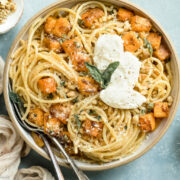
Butternut Squash Pasta Recipe
Equipment
- Large Pot
- Colander
- large skillet
Ingredients
- 12 ounces Pasta (Bucatini, Spaghetti or Linguine)
- ½ Cup Unsalted Butter - DIVIDED (1 stick)
- 1 large Butternut Squash (about 2 pound) – peeled, halved lengthwise, seeds discarded & cubed (1’’) (about 4 cups cubed squash)
- 1/2 tsp EACH: Ground Ginger, Nutmeg & Cumin
- Pinch Cayenne
- 2 Cloves Garlic – smashed and peeled
- 8-12 large Sage Leaves
- 1 Cup Whole-Milk Ricotta (Optional: Whip ricotta until smooth in a food processor)
- ½ Cup Toasted Walnuts – coarsely chopped
- Kosher Salt & Pepper - to taste
- 1/2 Cup Parmesan - freshly grated, plus more for garnish
Optional for garnish: Fresh Thyme and/or Fresh Parsley - chopped
Instructions
- Bring a large pot of water to a boil. Generously salt the water and add the pasta. Cook until al dente according to the package instructions. Drain, reserving 1 cup of the cooking water. Let pasta cool for 3 minutes.
- Meanwhile, cook squash: In a large skillet melt 2 tablespoons of the butter over medium-high heat. Add the squash, ginger, nutmeg, cumin, cayenne and season with salt and pepper. Cook, stirring occasionally at first and then more often as the squash browns, until the squash is browned and tender, about 12-15 minutes. Transfer the squash to a clean plate and set aside.
- Make the brown butter sauce: In the same skillet, add the remaining 6 tablespoons of butter. Add the smashed garlic and melt the butter, swirling pan until butter turns light brown, about 2 minutes. Add sage leaves and fry until crispy, about 30 seconds. Use a slotted spoon and transfer the sage leaves to paper towels to drain. Discard garlic.
- Finish the pasta: Reduce heat to medium-low. Slowly add in 1/2 cup of the reserved pasta cooking liquid. Whisk until combined. Remove pan from heat and add the pasta. Season generously with salt and pepper. Toss until the pasta is well coated. Add the parmesan cheese and toss well to combine. Add the butternut squash and very gently toss to combine. Add more cooking liquid to create a light, silky sauce if pasta looks dry. Taste and adjust for seasoning.
- Serve warm: Divide the pasta between serving plates. Top with a dollop of ricotta, walnuts, crispy sage leaves and more parmesan. Enjoy!
Video
Notes
- Butternut Squash Hack: To easily peel butternut squash, use a fork to pierce shallow holes all around the squash and then microwave it for 45 seconds to 2 minutes. Let cool and then proceed to peel it. Microwaving the squash softens the skin and makes it’s a cinch to peel!
- Pasta water: When boiling the pasta, make sure your water is generously salted. We are talking, as salty as the ocean. Cook the pasta until just AL DENTE and make sure you reserve 1 cup of the cooking water. You probably won't use the entire cup of reserved liquid in the sauce, but it is better to err on the safe side.
- Parmesan: Make sure you use fresh grated parmesan for this recipe. Pre-grated cheese will not seamlessly melt into the sauce.
Nutrition
Did you make this recipe?
Mention @nospoonnecessary on Instagram and tag it #nospoonnecessary!
©No Spoon Necessary. All images and content are under copyright protection. Please do not use any images without prior permission. Please do not publish this recipe without prior consent. If you want to reference this recipe, please do so by linking directly to this post.

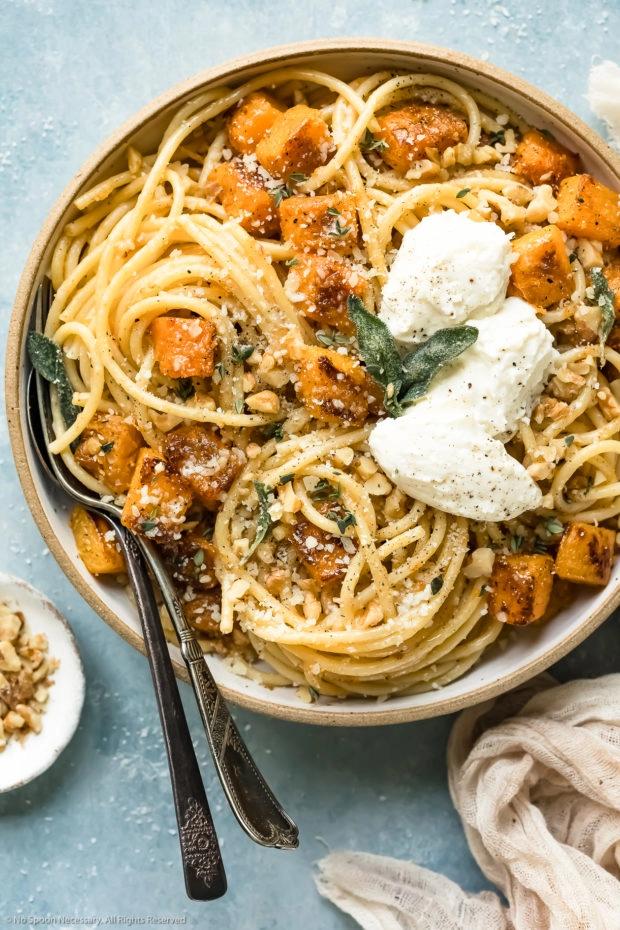
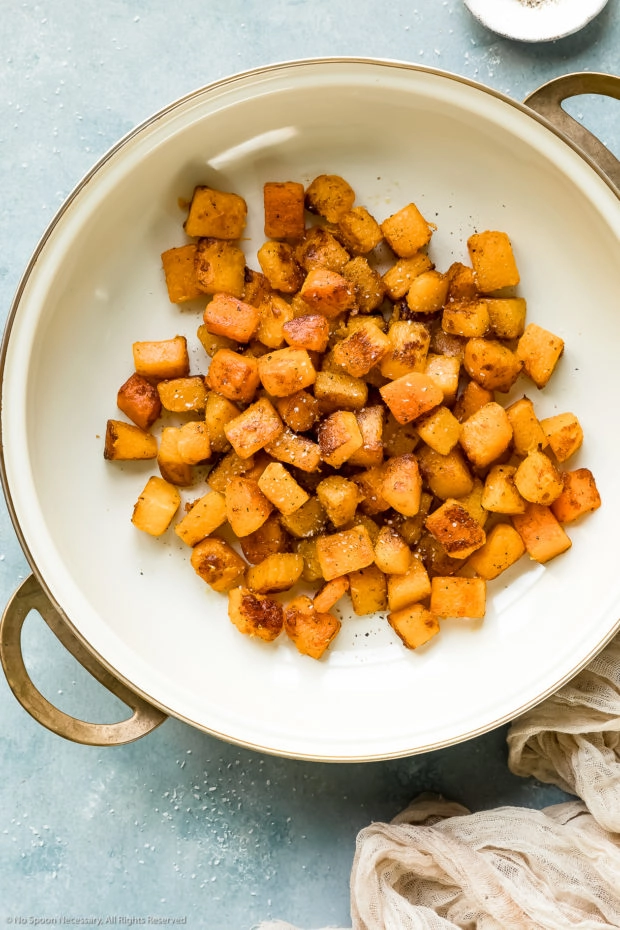
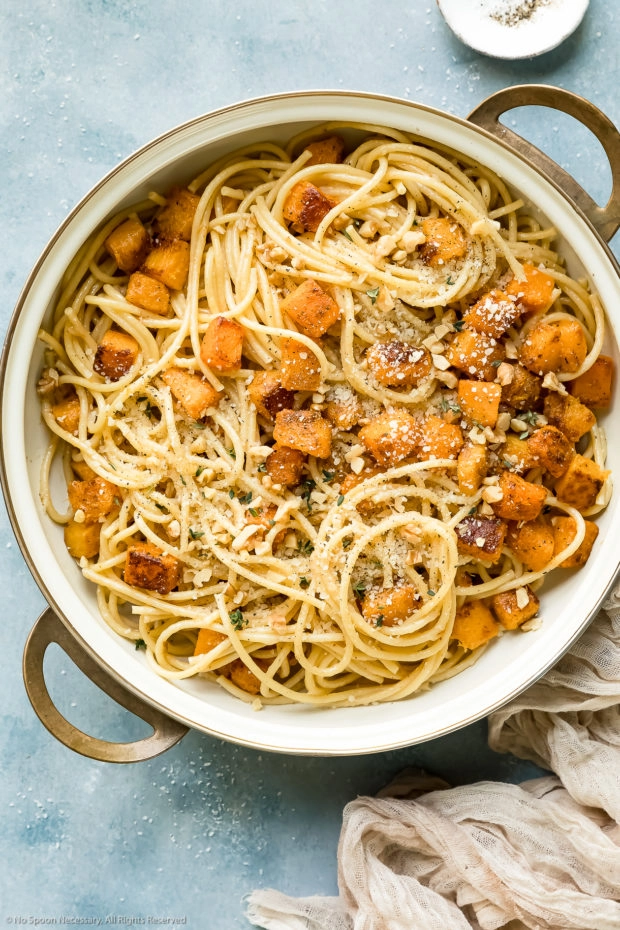
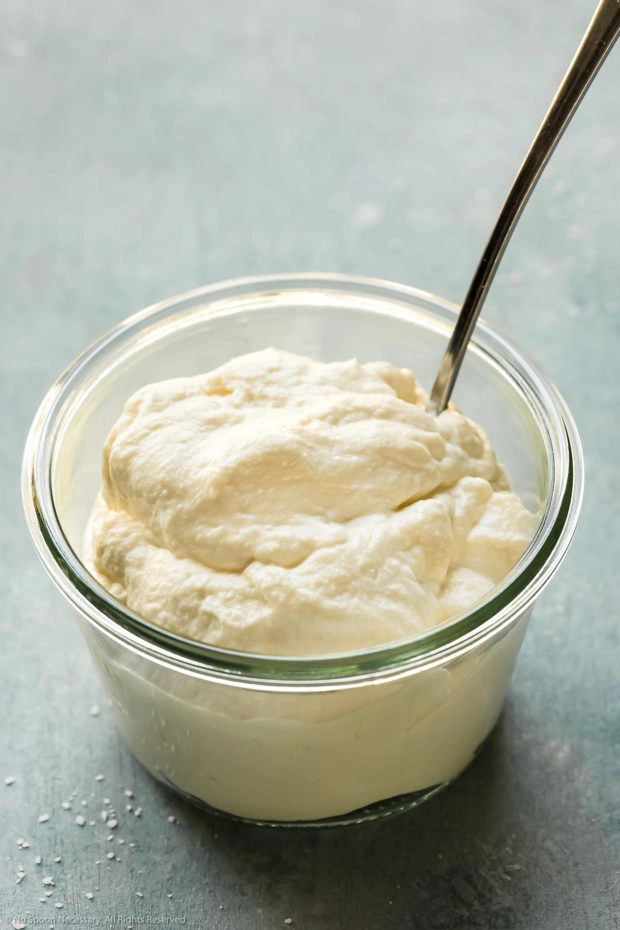
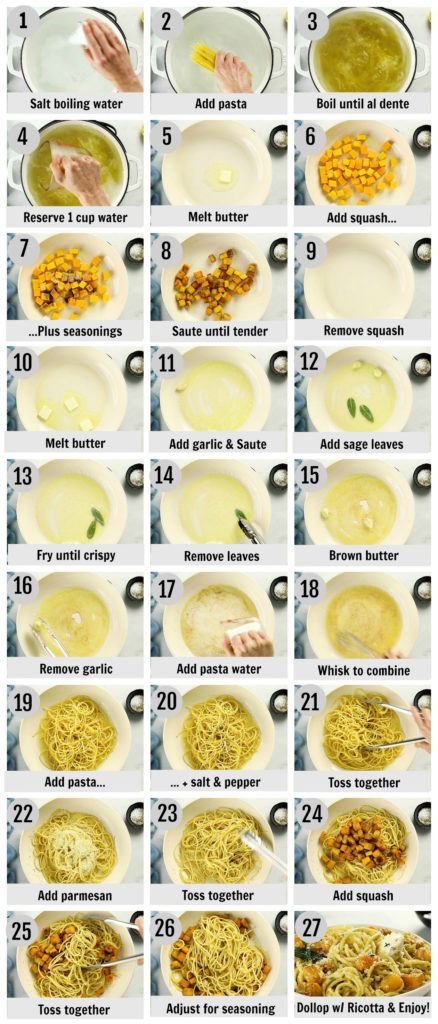
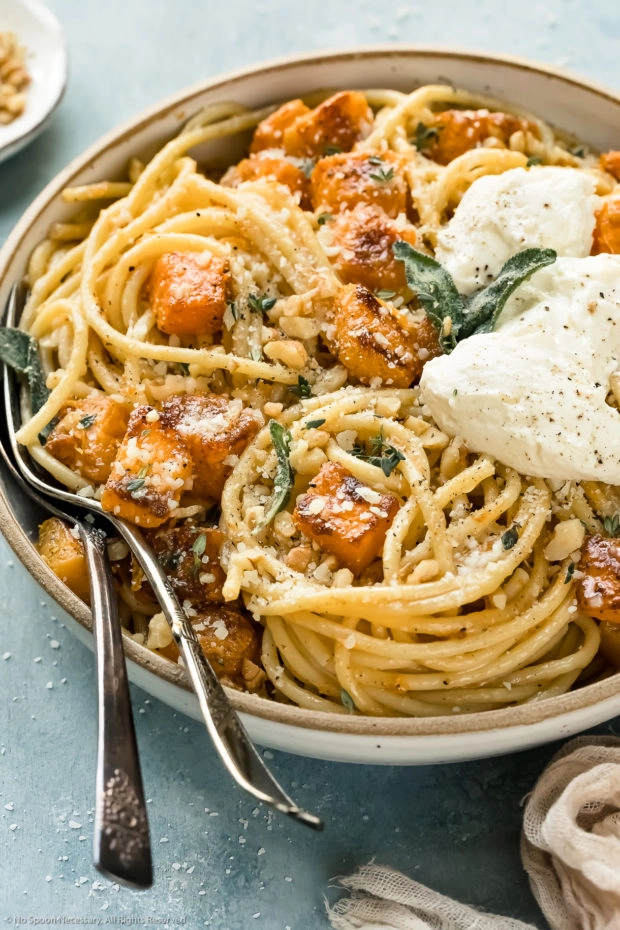
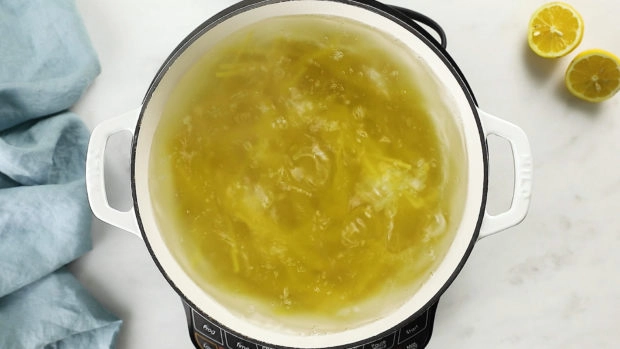
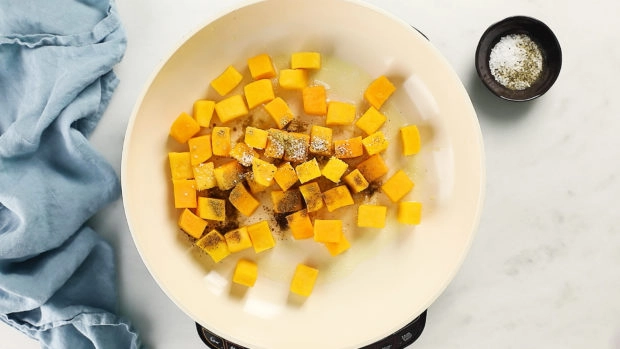
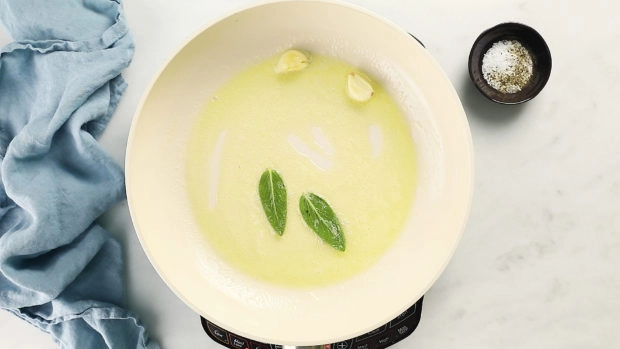
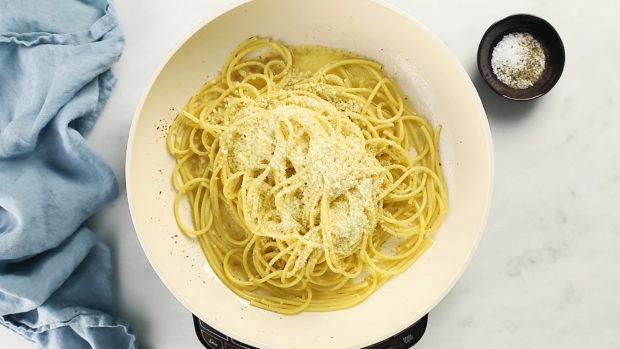
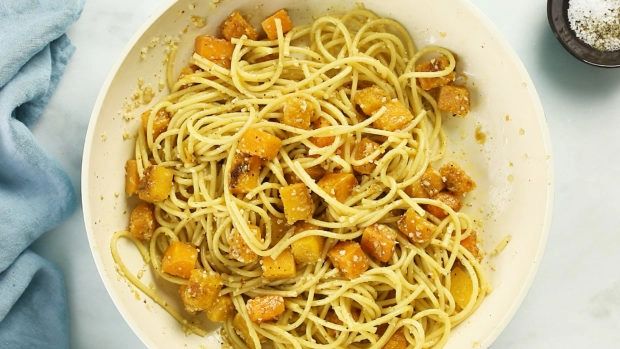
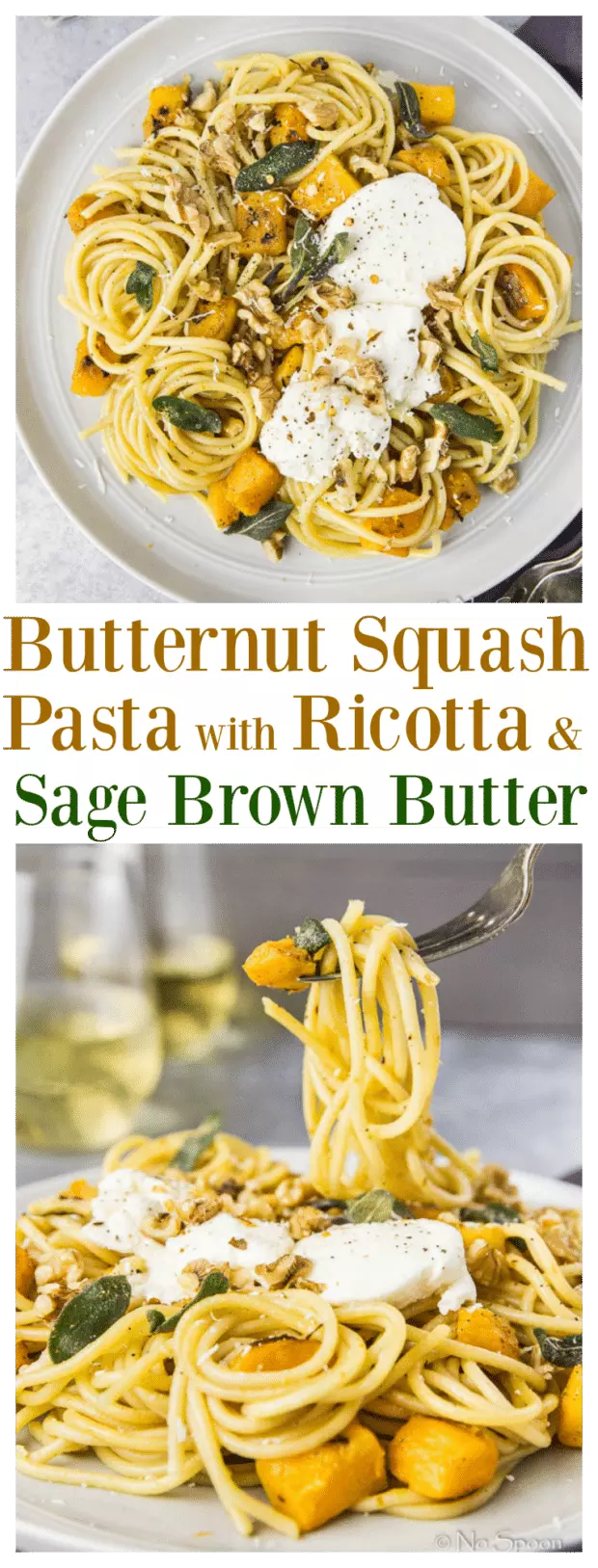
Carly
This is so good! I used toasted hazelnuts because I don’t love walnuts and it was FAB! I also air fried the butternut squash the second time around and it was just as good! Thank you!
Cheyanne
Hi Carly,
I’m thrilled you enjoyed the recipe! I absolutely love toasted hazelnuts, so your substitution sounds just fabulous! And, the air fryer!? Genius! Thank you for coming back and letting me know how everything went over! Cheers! 🙂
Kelly | Foodtasia
Chey, I’m so craving this butternut squash pasta! Butternut and sage are so yummy for fall. Love the fat, chewy pasta you’ve served it with. And that dollop of ricotta – swoooooooning!
Mary Ann | The Beach House Kitchen
I absolutely agree Chey! Totally winning in the fall dinner department. I LOVE butternut squash this time of year. And the added ricotta and sage brown butter make this a decadent dish I’m sure! Pinned!
Kelsie | the itsy-bitsy kitchen
Brown butter AND pasta AND butternut squash? If ever there was a pasta dish with my name written all over it, it’s this one! It just went right to the top of dishes I have to make, like, yesterday. This looks amazing, Chey!
Marissa
I just bought a butternut squash yesterday to do **something** with this week – now I know exactly what I’m going to make! This pasta is gorgeous, Cheyanne! Love how elegant it looks when it’s simple to make!
Ally
How would you suggest going about using organic dried sage leaves instead of fresh? No fresh sage was available locally right now :/ thank you!!
Cheyanne Bany
Hi Ally,
Fresh sage is a pretty integral part of this recipe. However, with that said, you could try substituting 3/4 – 1 teaspoon dried sage for the fresh. Please note that the brown butter will not taste as light and fresh as if you used sage leaves. To use dried sage, simply add it in the same place as directed for the sage leaves in the recipe, but instead of crisping the leaves and removing them, just stir in the dried sage and proceed with step 4 – adding the pasta. Thank you so much for stopping by! Cheers!
CakeSpy
OMG this looks incredible. I’d say that barilla is my go to brand too, not crazy pricey but the best one on the aisles for sure. I love the sage brown butter here – I think that would be good with pasta, potatoes, seriously, anything. Maybe not cereal, but then again I’ve never tried it. 😉
Simone | My Blueberry Basket
This is a fantastic recipe, Cheyanne! I’ve still got loads of sage, growing rampant in my herb garden. Now I know, how I can use some of it!
Hope you’ll have a better weekend this time!
All the best, Simone
Jess Wright @ The Cookbook Obsession
You had me hooked at sage and brown butter. Pasta is my go to comfort food choice. I can’t wait to try this!! 🙂 Beautiful picture by the way <3
Natalie | Natalie’s Food & Health
When you say Ricotta it’s like lightning of pure pleasure strikes me. I LOVE ricotta cheese. And freshly grated Parmesan on warm pasta? OMG! Just stop it! This butternut pasta looks amazing! It sounds amazing! I need this like right now. Can’t wait to try it. Thanks for sharing this Cheyanne. Cheers dear and have a great weekend! 😉
Harriet Emily
This pasta dish is gorgeous Cheyanne, such delicious Autumnal flavours! Yum! Pinned <3
Shashi at RunninSrilankan
Yowzers! Cheyanne – a plate of this would indeed chase the moody mellows away! This sounds so so fancy – but yay – it’s so so easy! When am on hold I usually just put the call on speaker and go about my bizness – but sometimes end up not paying any attention when the call is answered which leads to them hanging up on me and me having to call back which makes me now question the logic behind my supposed solution…hmm…but, I don’t question the deliciousness of this! We are fans of Barilla in our house too and gosh, my daughter might end up eating the screen if she saw your version! Happy Wednesday friend! Hoping the week is and will be better than meh for ya 🙂 xoxo
Kathleen | Hapa Nom Nom
I’m so sorry you had the hold from hell – always made worse by bad hold music. There is only one hold song I like (well….secretly love) and that’s Opus No.1. I’m not even joking, it’s the most popular hold music – so popular that people have tried to purchase it – or so I heard on NPR 🙂 In any event, this sounds just incredible! Lovin’ the seasonal butternut squash and with that ricotta and brown butter sage…. girl….you’re making my stomach growl!
Kushi
Love the colors and the flavors here! Sounds amazingly delicious. Can’t wait to give this a try!
Zainab
Ooooo brown butter on pasta is a KILLER!! You have me seriously on this recipe and I want it all.
Rachelle @ Beer Girl Cooks
Girl, I’m all about some stress baking when times get tough! You sure knocked it out of the park with this yummy pasta! I can’t help you with the elevator music, but I hope the office situation got straightened out! Pinned!
karrie @ Tasty Ever After
Yes to that big bowl of pasta and a big ol’ fork! YUMMMYMMY!! Love the flavors you put in this dish. Just picked up a butternut squash in my CSA and bucattini is my fav shape of pasta so will have to try this soon. Here’s to a better weekend ahead!
annie/ kitchen window clovers
Oh gosh you just named so many of my favorite things…..sage, bucattini (best long pasta shape, no question), oh creamy butternut squash. YUM. kudos for not throwing your phone through a window.
Nicole @ Young, Broke and Hungry
My motto is that pasta fixes any crummy day!
Cathy | whatshouldimakefor.com
this is epic fall comfort food. pasta and butternut squash. soooo good. love that you included the hack for peeling the squash. genius!
Mary
I ended up working all weekend Cheyanne, being an entrepreneur sounds great in theory but I’ve been working none stop with no end in sight, but that’s ok. its scary and exciting at the same time. I’m sorry to hear about your delivery debacle I had some problems with Amazon while moving into my new place, it took awhile to get it all sorted out, and that hold music is the WORST! I’m a fan of any pasta tossed in brown butter; I like the addition walnuts too. Not only do they add a needed crunch but also have a distinct nutty flavor that pairs perfectly with brown butter.
Beeta @ Mon Petit Four
This looks INCREDIBLE, Cheyanne! I love how you incorporated fall flavors into this pasta. I adore bucatini as well – it’s one of my favorites to make pasta dishes with! <3
Keri @ Fashionable Foods
Ugh, I hate that dang hold music, too! So annoying! Good thing you have this pasta to keep you happy and calm. I LOVE bucatini and am extremely sad gluten-free bucatini doesn’t exist (yet). Luckily Barilla has pretty phenomenal GF spaghetti that will have to do for this amazing looking recipe! You literally have all of my favorite things in this pasta, Cheyanne! Can’t wait to try it. Pinned!
Ashley – The Recipe Rebel
Those gorgeous twirls of carbs are getting to me. I hope you had a plate or two of this while you were waiting! I think it would definitely help to see me through. Lol. I hope you have a much better weekend this time around!
Anu – My Ginger Garlic Kitchen
Being put on hold is the worst thing. Sorry, that you had to face this. But this butternut squash pasta looks so bright and beautiful and this sure must have made your day. Love all the amazing flavors in this seasonal recipe. Love all the Fall colors in this cozy and comfy meal, Chey. Have a great week ahead.
Karen @ Seasonal Cravings
So sorry about all that elevator music and the hassle factor. I’m sure this creamy pasta made everything better. It looks like the perfect fall meal.
allie @ Through Her Looking Glass
Hi Chey – what a gorgeous meal! Love everything about this post. (Especially the alliteration.) I still have some sage growing in my herb pot – perfect use right here. I love the twirls of pasta on that plate – you rock! We had a great weekend around here, super busy though. Charlie had a soccer game that was quite a drive – but the foliage is peak now so it was a win win. Cheers to a wonderful week ahead for you my friend, and may it “hold” no hold music. (!) HA. XOXO
Kathy @ Beyond the Chicken Coop
I hope you got your order all figured out. There’s nothing worse than being on hold. I had to return a clothing item for my kids and the music there wasn’t elevator music….it was super loud teenage rock music! I think I might be scarred for life! Pasta and butternut squash sound delicious! They are a great combination and perfect for fall!
Ben Maclain
You’re such a lier, Chey! You mentioned once you’re more into apples than pumpkins. Well, I do also remember you’re partial to butternut squash, but that’s kind of pumpkin to me too:) Anyways, that’s THE PERFECT butternut squash pasta. That’s the way I make it, with sage, butter, and ricotta. Wait, there’s bacon or pancetta? Ok, I forgive you for this but just cause this is the fabulous pasta!
Sues
YES YES YES. I need this in front of me right now so I can gobble it all up and then lick the bowl clean. Who cares that I’m in bed and it’s 11:00 p.m.?! And ugh, hold music has so much potential, but always seems to be a huge fail!
mira
Sorry for this unpleasant experience girl! Hate being on hold and the music…
This pasta looks amazing! Love seasonal recipes like this! Pinned!
Ashley@CookNourishBliss
haha oh gosh I sooooo hate the hold music 99% of the time!! And even worse when you are stuck listening to it for hours!! Huge boo! But this pasta! Oh my goodness – just way way too many things that I love in here! I would eat like four bowls of this in one sitting!
Demeter | Beaming Baker
You MEAN you don’t like “40 minute flute solos”???? I’m gonna have to cancel all of the plans I made for when we meet up–it was totes gonna include me carrying a boombox, playing a flute solo on loop. Darn it. 😉 All jokes aside, sorry that the office delivery went south. But SO glad that you whipped up this amazing meal to help us be calm and happy… and more importantly comforted. 🙂 Looking at your food and drooling over it (attractively, of course) ALWAYS makes me feel good. So thank you. 🙂 Big hugs and high fives for kicking that grumpy ball of habit-wrecking delivery shenanigans in the face with this amazing meal! Pinning, of course! xoxoxo
marcie
Hold music is horrible, and I love when they give you option to mute it! Heck yeah I want to hold in silence. 🙂 You’re the food styling queen — your plates are always SO pretty! I love everything in this pasta and I’m adding it to my meal plan — everyone in the house will love this!
Stephanie | The Foodie and The Fix
Now THAT’S a pretty pasta! What a comforting, cozy meal, Chey! One of the many reasons I love this time of year is all of the awesome winter squash 🙂 It sucks getting stuck on the phone like that! So sorry that you had to waste a day on that! I did actually have a pretty fantastic Saturday, the fam and I took a long hike through an enchanted forest (well, that’s what my 9 yr old calls it!) to this pretty beach. We ate lunch there, searched for sea shells and jelly fish and hiked back. We mostly chilled on Sunday, we were all so beat from the hike! Pinning this beautiful meal, friend!
Stacey @ the sugar coated cottage
Lol, you’re so right! And do u notice it’s not just bad music but it crackles and goes high pitch randomly! No wonder u made something so comforting. I’m loving the carmelized squash, brown butter and ricotta combo!! Delicious!! Take care.
Lauren Gaskill
I’m sorry you spent most of your Saturday on the phone dealing with something that went wrong! My weekend was good and bad … good because my in-laws were visiting. Bad because I’m fighting the worst sinus infection I’ve ever had. Just need to make it through this week…
By the way, this dish is on point! You know I love me some brown butter. <3 <3 XOXO
Kevin | Keviniscooking
HOLD music is punishment, like “why are you calling us?” and when they give you an option to press a number to change the music and it DISCONNECTS you? Then I’ve had it.
It must be squash day, right?! Loved reading your peeling tip, I usually picked up the cut, cubed ones from Costso so I eat it more often, but that’s way cool. This one sounds mighty tasty, thanks!
Amanda
I have yet to try brown butter on pasta. What am I waiting for? My goodness this looks good. And all that ricotta! Comfort food indeed!
Geraldine | Green Valley Kitchen
Yum, Cheyanne – I’d love a great big blow of this – it looks so delicious. I never think of adding butternut squash to pasta but I bet it’s absolutely wonderful. Definitely making (and pinning) this! Sorry about the on hold drama – that’s the worst!
Adina
Your pasta dishes always look amazing! This idea with sage is great, I still have so much of it in the garden.
Gaila
I just hate it when online shopping goes wrong!! if you are ordering online it supposed to go smoothly! but any who! I gather you solved your little glitch by now. But this pasta sounds and looks amazing Chey!! Well done my friend!
Mary Ann | The Beach House Kitchen
What a fabulous fall flavored pasta dish Chey! You definitely get a high five from me on this one! Love it all. Hope you have a fabulous week! XO
Jennifer @ Seasons and Suppers
Such a beautiful pasta dish! I’m all about the Fall flavours and the butternut squash and sage butter is on point 🙂 Love Barilla pasta and especially bucatini.
annie@ciaochowbambina
Saturday was pretty exciting…our team, SU, beat #17 VT! It doesn’t get any better than that! Yesterday was pretty chill…Sunday chores – you know how that goes. This pasta is everything fall food should be! So cozy and delicious!! Happy Monday, my friend! xo
Megan – The Emotional Baker
I hate being put on hold – boo!! The worst part is wondering if they’re ever going to come back to the phone!! This pasta would help calm me after a stressful phone call 🙂
Dawn @ Girl Heart Food
Ahhh….that dang elevator music!! Maybe, it’s just as well they don’t play any music, right?? We had a pretty low key weekend, but that’s not a bad thing 😉 And I love pasta any day, any time. You’re right…it’s just so comforting, but equally important, tasty! And this recipe here got all kinds of goodness goin’ on! Loves me some butter, especially that wonderful taste of brown butter and ricotta? And texture from nuts? Woo hoo! Sign me up 🙂 Pinned, of course. Hope you have a wonderful week, Chey! xo
Gayle @ Pumpkin ‘N Spice
Hold music is the worst! And it always seems to go in and out or be so staticy, too! Hope you were able to get your issue resolved. And yay for comfort food! Pasta is also my go-to meal when I need a little pick-me-up, so I’m loving this butternut squash version! You definitely captured the flavors of fall right here. And with ricotta and sage? YUM! I wish you delivered, because I could go for this for breakfast right about now! 🙂 Pinned! Hope your week is off to a great start!
Kathryn @ Family Food on the Table
Love how easy this is to make yet it’s so elegant and has tons of great fall flavors! My kind of weeknight pasta deliciousness! Sorry about the phone fiasco though – NOT a good way to spend a Saturday! Hope it got all straightened out and that you can find some time this week to have weekend fun during the week to make up for it 😉 XO
Vivian | stayaliveandcooking
Arrggghh nothing more frustrating than being kept on hold for so long! I’ve had my fair share – and then you get that frustrating voice saying “there are… SIX people before you” uggh! I hope you got it sorted out…
As for this pasta (which is my comfort food too) it looks and sounds delicious! I don’t know if I told you but last January we went to Rome, Italy and that was the first time I had sage butter gnocchi. I fell in LOVE instantly!! So simple yet so good! So now every time I see the words “sage” and “butter” in a recipe, I just have to check it out. 😉
Congrats on the collaboration! Have a great week xx
Angie@Angie’s Recipes
This is truly very comforting and flavoursome with ricotta, sage and brown butter. An awesome Fall dish, Cheyanne.